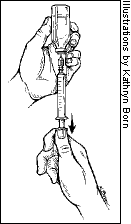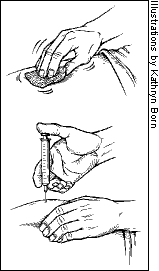Dr. MJ Bazos MD,
Patient Handout
Insulin
What is insulin?
Insulin is a hormone that controls the level of
blood sugar (also called glucose) in your body. People with diabetes may not
have enough insulin or may not be able to use it properly. The sugar then builds
up in the blood and overflows into the urine, passing out of your body unused.
This deprives you of an important source of energy.
Why do I need insulin?
All people with type 1 diabetes, and some people
with type 2, need to take insulin to help control their blood sugar levels. Type
1 diabetes means your body doesn’t make any insulin. Type 2 diabetes means
your body either doesn’t make enough insulin or doesn’t use it
properly.
The goal of taking insulin is to keep your blood
sugar level in a normal range as much as possible so you’ll stay healthy.
Over time, high blood sugar levels can cause serious health problems such as
blindness and kidney failure.
How often will I need to take
insulin?
Your doctor will work with you to develop a
schedule that works for you. Most people with diabetes who take insulin need at
least 2 insulin shots a day for good blood sugar control. Some people need 3 or
4 shots a day.
Do I need to monitor my blood sugar
level?
Yes. If you don’t already monitor your
blood sugar level, you will need to learn how. Your doctor will teach you.
When should I take insulin?
You and your doctor should discuss when and how
you will take your insulin. Each person’s treatment is individualized.
Some people who use Regular insulin or a longer-acting insulin take it 15 to 30
minutes before a meal. Some people who use insulin lispro (brand name: Humalog)
take it just before they eat.
|
Types of insulin
Quick-acting, such as insulin lispro,
begins to work very quickly (5 to 15 minutes) and lasts 3 to 4 hours.
Short-acting, such as Regular (R)
insulin, starts working within 30 minutes and lasts about 5 to 8 hours.
Intermediate-acting, such as NPH (N) or
Lente (L) insulin, starts working in 1 to 3 hours and lasts 16 to 24 hours.
Long-acting, such as Ultralente (U)
insulin, doesn’t start to work for 4 to 6 hours, but lasts 24 to 28 hours.
Another long-acting insulin, called insulin glargine, starts working within 1 to
2 hours and lasts 24 hours.
NPH and Regular insulin mixture, two
types of insulin mixed together in one bottle, starts working in 30 minutes and
lasts 16 to 24 hours.
Source: Medicine for People with
Diabetes. National Diabetes Information Clearinghouse, NIH Publication No.
00-4222, May 2000.
|
Where should I inject the insulin?
|
|
|
Picture 1. Pull back on the plunger to
draw insulin into the syringe.
|
|
|
|
|
|
Picture 2. Clean the injection area using
cotton and alcohol (top). Pinch an area of skin and inject insulin
(bottom).
|
The usual places to inject insulin are the upper
arm, the front and side of the thighs, and the abdomen (tummy area). Ask your
doctor which place you should use. Insulin injected near the stomach works
fastest, while insulin injected into the thigh works slowest. Insulin injected
into the arm works at medium speed.
How do I take insulin?
Insulin is normally injected under the skin with
a very small needle. It can also be taken with an insulin pen. Your doctor will
teach you how to inject insulin. Follow your doctor’s advice. Here are
some general tips on using insulin:
- Wash your hands.
- Take the plastic cover off of the insulin bottle
and wipe the top of the bottle with a cotton swab that you have dipped in
alcohol.
- Pull back the plunger of the syringe, drawing air
into the syringe equal to the dose of insulin that you are taking (measured in
units). Put the syringe needle through the rubber top of the insulin bottle.
Inject air into the bottle by pushing the syringe plunger forward. Turn the
bottle upside down.
- Make sure that the tip of the needle is in the
insulin. Pull back on the syringe plunger to draw the correct dose of insulin
into the syringe (PICTURE 1).
- Make sure there are no air bubbles in the syringe
before you take the needle out of the insulin bottle. If there are air bubbles,
hold the syringe and the bottle straight up, tap the syringe with your finger
and let the air bubbles float to the top. Push on the plunger of the syringe to
move the air bubbles back into the insulin bottle. Then withdraw the correct
insulin dose by pulling back on the plunger.
- Clean your skin with cotton dipped in alcohol
(PICTURE 2, top). Grab a fold of skin and inject the insulin at a 90-degree
angle (PICTURE 2, bottom). (If you’re thin, you may need to pinch the skin
and inject the insulin at a 45-degree angle.)
What happens if I
take too much insulin?
If you take too much insulin it will lower your
blood sugar level too much, and you may get hypoglycemia (also called an insulin
reaction). When you have hypoglycemia, you may feel cranky, more tired than
usual, confused and shaky, and you may sweat more. In serious cases, you can
pass out or have a seizure. Talk to your doctor about how to treat hypoglycemia.
Your doctor may suggest that you always carry a snack with you, such as candy,
fruit juice or regular (not diet) soda, to treat hypoglycemia.
Websites:



